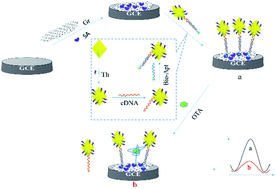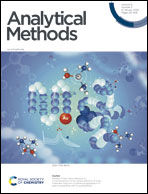Development of an electrochemical aptasensor using Au octahedra and graphene for signal amplification
Abstract
A novel electrochemical aptasensor was constructed for ochratoxin A (OTA) detection based on Au octahedra and graphene (GR) as a signal amplification strategy. Au octahedra with eight triangle faces and sharp corners were prepared and acted as carriers to connect more thionine (Th) and complementary DNA (cDNA) to form Th–Au octahedra–cDNA. Th–Au octahedra–dsDNA was formed by hybridizing OTA aptamers with cDNA. GR with high surface area and good conductivity immobilized more biomolecules and facilitated electron transfer on the electrode surface. Th–Au octahedra–dsDNA was immobilized on the GR/GCE surface, producing a large initial peak current. In the presence of OTA, the formation of the aptamer–OTA complex induced the release of Th–Au octahedra–cDNA from the electrode surface and decreased the electrochemical signal of Th. The proposed aptasensor exhibited a wider linear range from 0.001 to 5 ng mL−1 with a lower detection limit of 0.13 pg mL−1; it also showed good selectivity against common interferences, including AFB1, ZEA and FB1.



 Please wait while we load your content...
Please wait while we load your content...